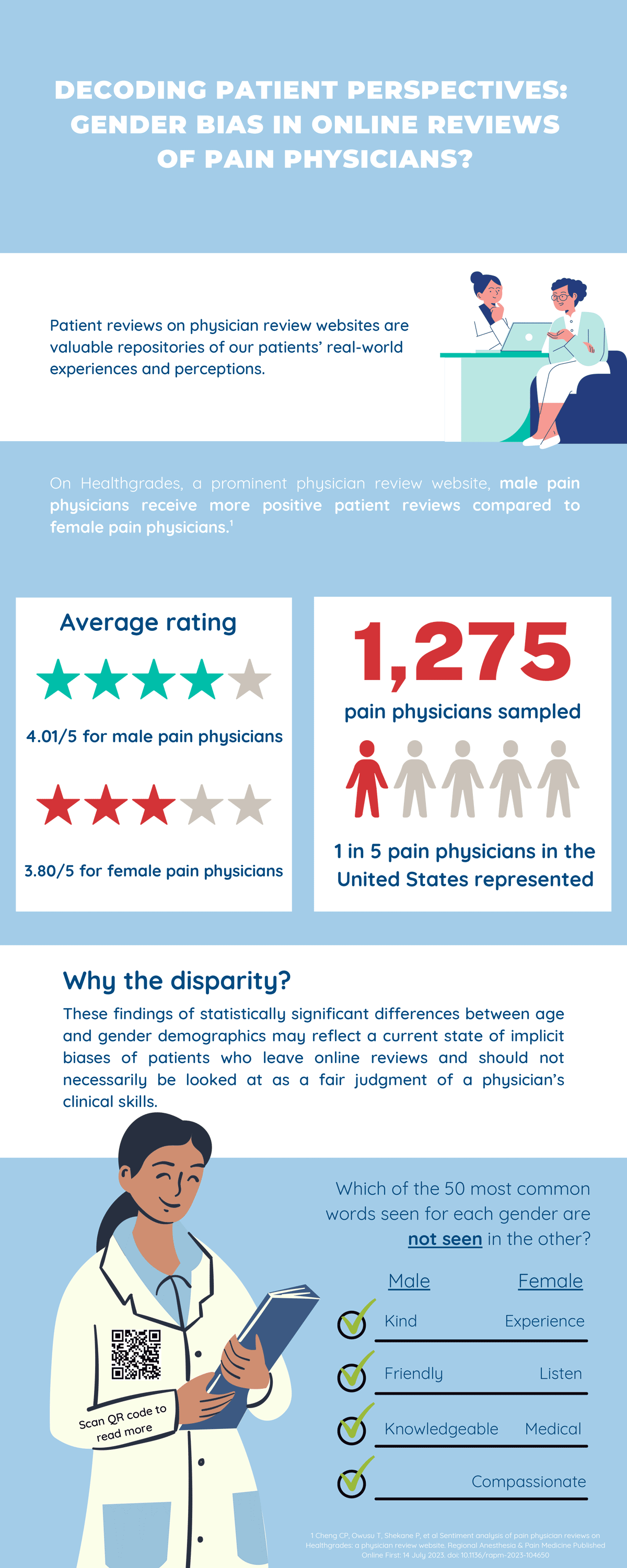Decoding Patient Perspectives: What Online Reviews Reveal About Pain Medicine Physicians
Cite as: Cheng C, Shekane P, Patel A. Decoding patient perspectives: what online reviews reveal about pain medicine physicians. ASRA Pain Medicine News 2024;49. https://doi.org/10.52211/asra020124.010.
Research indicates that the patient-caregiver relationship significantly influences adherence to treatment, especially in chronic pain treatment.1 Understanding and improving patient perceptions is not only crucial for enhancing patient outcomes but also for shaping the financial landscape healthcare providers face. Seventy-seven percent of patients rely on reviews on physician review websites (PRWs) to find doctors.2
Understanding patient perspectives helps to shape a more compassionate, effective, and patient-driven approach to pain medicine. In this study, 15,101 reviews of 1,275 pain physicians were analyzed from the PRW Healthgrades, considering factors like gender, age, and practice region.
With the patient reviews parsed into numbers, we compared sentiment scores and star ratings based on physician gender and age. We were also able to identify the words and bigrams that were most frequently used by patients in their positive and negative reviews.
- Comparison by Gender and Age: Male pain physicians received higher star ratings and sentiment scores compared to female pain physicians. Similarly, younger physicians received higher ratings and sentiment scores than their older counterparts.
- Word and Bigram Frequency: Positive reviews commonly featured words like caring, professional, and kind while negative reviews often mentioned pain, back, and time.

The revealed biases in favor of male and younger pain physicians underscore the potential biases against women and older physicians. Several gender inequities exist within the field of pain medicine, such as disadvantages in career advancement, consideration for leadership positions, and financial compensation. In this study, we uncovered another gender disparity that women physicians may face from patients. The lower ratings could be demonstrative of implicit biases women physicians face from patients within the healthcare system. Patients should also approach reviews cautiously, recognizing that preferences expressed in reviews may not necessarily align with the clinical competence of the physician.
Moreover, the study confirms that patients value qualities like empathy, compassion, and approachability in their pain physicians. In conclusion, pain physicians should prioritize not only clinical excellence but also the cultivation of interpersonal skills that foster trust and comfort.



References
- Zolnierek KB, Dimatteo MR. Physician communication and patient adherence to treatment: a meta-analysis. Med Care 2009;47:826-34. https://doi.org/10.1097/MLR.0b013e31819a5acc
- Morris L. How patients use online reviews. Software Advice. https://www.softwareadvice.com/resources/how-patients-use-online-reviews. Published April 3, 2020. Accessed Month Day, Year.
- Cheng CP, Owusu T, Shekane P, et al. Sentiment analysis of pain physician reviews on healthgrades: a physician review website. Reg Anesth Pain Med 2023;rapm-2023-104650. https://doi.org/10.1136/rapm-2023-104650